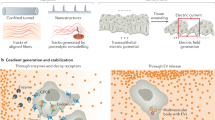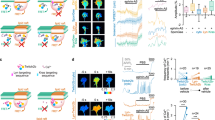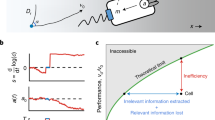Abstract
Axonal chemotaxis is believed to be important in wiring up the developing and regenerating nervous system, but little is known about how axons actually respond to molecular gradients. We report a new quantitative assay that allows the long-term response of axons to gradients of known and controllable shape to be examined in a three-dimensional gel. Using this assay, we show that axons may be nature's most-sensitive gradient detectors, but this sensitivity exists only within a narrow range of ligand concentrations. This assay should also be applicable to other biological processes that are controlled by molecular gradients, such as cell migration and morphogenesis.
This is a preview of subscription content, access via your institution
Access options
Subscribe to this journal
Receive 12 print issues and online access
$209.00 per year
only $17.42 per issue
Buy this article
- Purchase on Springer Link
- Instant access to full article PDF
Prices may be subject to local taxes which are calculated during checkout



Similar content being viewed by others
References
Tessier-Lavigne, M. & Placzek, M. Target attraction - are developing axons guided by chemotropism? Trends Neurosci. 14, 303–310 (1991).
Song, H. & Poo, M.-M. The cell biology of neuronal navigation. Nat. Cell Biol. 3, E81–E88 (2001).
Dickson, B.J. Molecular mechanisms of axon guidance. Science 298, 1959–1964 (2002).
Huber, A.B., Kolodkin, A.L., Ginty, D.D. & Cloutier, J.F. Signaling at the growth cone: ligand-receptor complexes and the control of axon growth and guidance. Annu. Rev. Neurosci. 26, 509–563 (2003).
Zigmond, S.H. Ability of polymorphonuclear leukocytes to orient in gradients of chemotactic factors. J. Cell. Biol. 75, 606–616 (1977).
Moghe, P.V., Nelson, R.D. & Tranquillo, R.T. Cytokine-stimulated chemotaxis of human neutrophils in a 3-D conjoined fibrin assay. J. Immunol. Methods 180, 193–211 (1995).
Foxman, E.F., Campbell, J.J. & Butcher, E.C. Multistep navigation and the combinatorial control of leukocyte chemotaxis. J. Cell Biol. 139, 1349–1360 (1997).
Knapp, D.M., Helou, E.F. & Tranquillo, R.T. A fibrin or collagen gel assay for tissue cell chemotaxis: assessment of fibroblast chemotaxis to GRGDSP. Exp. Cell Res. 247, 543–553 (1999).
Letourneau, P.C. Chemotactic response of nerve fiber elongation to Nerve Growth Factor. Dev. Biol. 66, 183–196 (1978).
Zheng, J.Q., Felder, M. & Conner, J.A. & Poo, M.-M. Turning of growth cones induced by neurotransmitters. Nature 368, 140–144 (1994).
Rosentreter, S.M. et al. Response of retinal ganglion cell axons to striped linear gradients of repellent guidance molecules. J. Neurobiol. 37, 541–562 (1998).
Bagnard, D., Thomasset, N., Lohrum, M., Puschel, A.W. & Bolz, J. Spatial distributions of guidance molecules regulate chemoattraction and chemorepulsion of growth cones. J. Neurosci. 20, 1030–1035 (2000).
Cao, X. & Shoichet, M.S. Defining the concentration gradient of nerve growth factor for guided neurite outgrowth. Neuroscience 103, 831–840 (2001).
Dertinger, S.K., Jiang, X., Li, Z., Murthy, V.N. & Whitesides, G.M. Gradients of substrate-bound laminin orient axonal specification of neurons. Proc. Natl. Acad. Sci. USA 99, 12542–12547 (2002).
Crank, J. The Mathematics of Diffusion, Second edition. (Oxford, Clarendon Press, 1975).
Levi-Montalcini, R. The Nerve Growth Factor: 35 years later. Science 237, 1154–1162 (1987).
Gundersen, R.W. & Barrett, J.N. Neuronal chemotaxis: chick dorsal-root axons turn toward high concentrations of nerve growth factor. Science 206, 1079–1080 (1979).
Paves, H. & Saarma, M. Neurotrophins as in vitro growth cone guidance molecules for embryonic sensory neurons. Cell Tissue Res. 290, 285–297 (1997).
Caton, A. et al. The branchial arches and HGF are growth-promoting and chemoattractant for cranial motor axons. Development 127, 1751–1766 (2000).
Soeda, H. et al. Functional characterization of calcium channels localized on the growth cones of cultured rat dorsal root ganglion cells. Neurosci. Lett. 325, 5–8 (2002).
Phillips, H.S. & Armanini, M.P. Expression of the trk family of neurotrophin receptors in developing and adult dorsal root ganglion neurons. Phil. Trans. R. Soc. Lond. B 351, 413–416 (1996).
Conti, A.M., Fischer, S.J. & Windebank, A.J. Inhibition of axonal growth from sensory neurons by excess nerve growth factor. Ann. Neurol. 42, 838–846 (1997).
Parent, C.A. & Devreotes, P.N. A cell's sense of direction. Science 284, 765–770 (1999).
Firtel, R.A. & Chung, C.Y. The molecular genetics of chemotaxis: sensing and responding to chemoattractant gradients. Bioessays 22, 603–615 (2000).
Berg, H.C. & Purcell, E.M. Physics of chemoreception. Biophys. J. 20, 193–219 (1977).
Goodhill, G.J. & Urbach, J.S. Theoretical analysis of gradient detection by growth cones. J. Neurobiol. 41, 230–241 (1999).
Ming, G.L. et al. Adaptation in the chemotactic guidance of nerve growth cones. Nature 417, 411–418 (2002).
Tranquillo, R.T. Theories and models of gradient perception. in Biological Motion (eds. Alt, W. & Hoffmann, G.) 415–441 (Springer-Verlag, Berlin, 1990).
Gallo, G., Lefcort, F.B. & Letourneau, P.C. The trkA receptor mediates growth cone turning toward a localized source of nerve growth factor. J. Neurosci. 17, 5445–5454 (1997).
Esposito, D. et al. The cytoplasmic and transmembrane domains of the p75 and Trk A receptors regulate high affinity binding to nerve growth factor. J. Biol. Chem. 276, 32687–32695 (2001).
Goodhill, G.J. Mathematical guidance for axons. Trends Neurosci. 21, 226–231 (1998).
Weaver, C.M., Pinezich, J.D., Lindquist, W.B. & Vazquez, M.E. An algorithm for neurite outgrowth reconstruction. J. Neurosci. Methods 124, 197–205 (2003).
Acknowledgements
We thank J. Savich, R. Arevalo, S. Mittar, C. Fleury and J. Torri for their assistance with technology development. Supported by the National Institutes of Health, the National Science Foundation, the Department of Defense and the Whitaker Foundation.
Author information
Authors and Affiliations
Corresponding author
Ethics declarations
Competing interests
The authors declare no competing financial interests.
Rights and permissions
About this article
Cite this article
Rosoff, W., Urbach, J., Esrick, M. et al. A new chemotaxis assay shows the extreme sensitivity of axons to molecular gradients. Nat Neurosci 7, 678–682 (2004). https://doi.org/10.1038/nn1259
Received:
Accepted:
Published:
Issue Date:
DOI: https://doi.org/10.1038/nn1259
This article is cited by
-
Baccharin from Brazilian green propolis induces neurotrophic signaling pathways in PC12 cells: potential for axonal and synaptic regeneration
Naunyn-Schmiedeberg's Archives of Pharmacology (2022)
-
Chemokine receptor CXCR7 non-cell-autonomously controls pontine neuronal migration and nucleus formation
Scientific Reports (2020)
-
Large-scale acoustic-driven neuronal patterning and directed outgrowth
Scientific Reports (2020)
-
High-throughput three-dimensional chemotactic assays reveal steepness-dependent complexity in neuronal sensation to molecular gradients
Nature Communications (2018)
-
Chemotactic responses of growing neurites to precisely controlled gradients of nerve growth factor
Scientific Data (2018)



